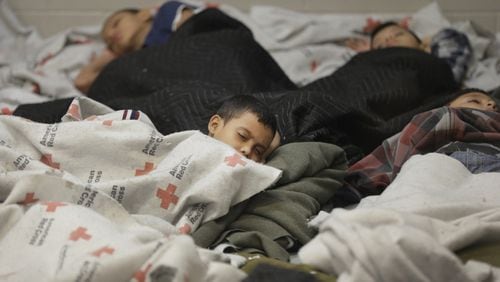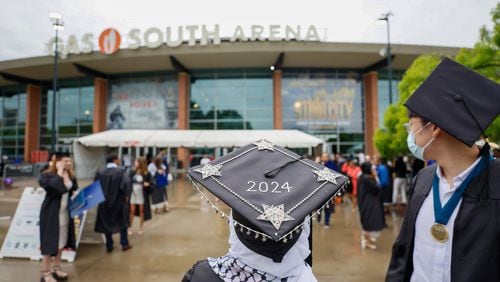In 2021, the number of unaccompanied migrant children who arrived to the U.S. and were sent to live with Georgia adults not related to them was 464. It was a stark increase from years prior – and a significant red flag for human trafficking and immigration advocates worried about children’s welfare.
The surge in migrant children living with near-strangers in Georgia and across the country is captured in a data set kept by the U.S. Department of Health and Human Services, the agency in charge of placing unaccompanied minors with adult sponsors. That data set was published at the end of last year by The New York Times.
From 2015 to 2020, an average of 60 migrant children were released each year to Georgia sponsors who weren’t their relatives, according to the HHS records. That included a mix of adults who were labeled as “family friends” and “unrelated sponsors.” By 2021, the number of children who were released to such adults in Georgia reached 464. The following year, the last one captured in full by the HHS data set, 427 children were sent by federal authorities to live in Georgia with people who weren’t their parents, siblings, aunts or uncles, or other relatives.
Migrant children, especially girls, being released to unrelated sponsors “always raises a red flag,” said Andrea Landers, an immigration attorney with Atlanta Legal Aid who helps provide free legal representation to migrant children in the area. “We’ve had a few cases where a teenager is placed with a non-relative or a friend of the family and those always give me pause and make me want to ask, especially outside the presence of the sponsor, about how things are going, if things are really okay.”
From 2015 to 2020, an average of 42.5% of unaccompanied children who came to Georgia were sent to live with a parent sponsor every year. In 2021 and 2022, that percentage dropped to 33.5%.
Last summer, The Atlanta Journal-Constitution told the story of Emilia, who came to the U.S. at 16 because she wanted to flee poverty and violence in her native Honduras. After being held in federal custody for about two months, she was released by HHS into the Marietta home of a male family friend, whom she had last seen when she was eight years old. Emilia settled into her unrelated sponsor’s home in the summer of 2021. A few months later, Emilia accused her sponsor of sexually assaulting her on two occasions. Cobb County police opened an investigation that is still ongoing.
“Nothing went as I had hoped,” she told the AJC from a homeless youth shelter she had to move to. The newspaper is not using Emilia’s full name in keeping with its policy against naming the victims of sexual assault.
According to Rebeca Salmon, an Atlanta child welfare advocate and lawyer who worked with Emilia and another migrant girl in a similar situation, placing children in the custody of unrelated sponsors is a “recipe for disaster.”
“The system is flawed,” she told the AJC in 2023.
That’s a characterization the government would disagree with.
A spokesman for HHS’ Administration for Children and Families told the AJC in a statement that HHS “works diligently to make sure every placement decision is made in the best interest of the child.” The spokesman added that, although HHS collaborates with law enforcement and other partners when it learns that children’s safety is at risk, its “custodial responsibilities end when a child is released from” care.
If more unaccompanied migrant children like Emilia are ending up in the homes of adults they aren’t related to, that’s in large part because the number of overall children arrivals at the border has increased drastically starting in 2021 – a product of the devastation the pandemic wrought on economies across Latin America. But it also true that a higher proportion of unaccompanied children arriving to the country starting in 2021 were released to unrelated sponsors, pointing to an increased willingness on the part of immigration authorities to release minors to strangers as opposed to parents or direct relatives.
The number of children made their way to the border in 2020 was low as a result of shelter-in-place measures and border closures registered across the continent at that time.
According to the U.S. Department of Labor, the increase of children arrivals to the country has coincided with a spike in violations of child labor laws. The New York Times and others have documented that, while parents and siblings often support the children who move in with them, other adults are more likely to accept custody of the children on the condition that they work and pay rent.
Before migrant children are released from federal custody and into adult sponsors’ homes, HHS performs a series of background checks. Unrelated sponsors are subject to a slightly more intensive degree of vetting.
But advocates say immigration authorities don’t do nearly enough follow up with children after releasing them to ensure they are being treated well.
“I mean you can screen and try to vet a sponsor for a year and a half, you’re not going to really know what happens until the kids get there,” said Jennifer Podkul, vice president for policy and advocacy at Kids in Need of Defense (KIND), an organization that provides legal services to unaccompanied minors.
More robust follow-up services would “make a world of difference for their safety.”
The Atlanta Journal-Constitution and Report for America are partnering to add more journalists to cover topics important to our community. Please help us fund this important work at ajc.com/give
About the Author







